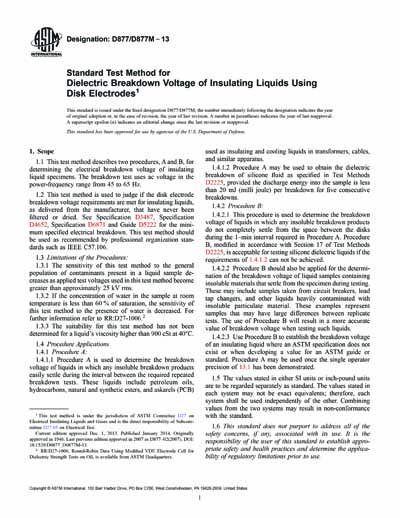Historical
ASTM D877/D877M-13
Standard Test Method for Dielectric Breakdown Voltage of Insulating Liquids Using Disk Electrodes
1.1 This test method describes two procedures, A and B, for determining the electrical breakdown voltage of insulating liquid specimens. The breakdown test uses ac voltage in the power-frequency range from 45 to 65 Hz.
1.2 This test method is used to judge if the disk electrode breakdown voltage requirements are met for insulating liquids, as delivered from the manufacturer, that have never been filtered or dried. See Specification D3487, Specification D4652, Specification D6871 and Guide D5222 for the minimum specified electrical breakdown. This test method should be used as recommended by professional organization standards such as IEEE C57.106.
1.3 Limitations of the Procedures:
1.3.1 The sensitivity of this test method to the general population of contaminants present in a liquid sample decreases as applied test voltages used in this test method become greater than approximately 25 kV rms.
1.3.2 If the concentration of water in the sample at room temperature is less than 60 % of saturation, the sensitivity of this test method to the presence of water is decreased. For further information refer to RR:D27-1006.2
1.3.3 The suitability for this test method has not been determined for a liquid's viscosity higher than 900 cSt at 40°C.
1.4 Procedure Applications
1.4.1 Procedure A:
1.4.1.1 Procedure A is used to determine the breakdown voltage of liquids in which any insoluble breakdown products easily settle during the interval between the required repeated breakdown tests. These liquids include petroleum oils, hydrocarbons, natural and synthetic esters, and askarels (PCB) used as insulating and cooling liquids in transformers, cables, and similar apparatus.
1.4.1.2 Procedure A may be used to obtain the dielectric breakdown of silicone fluid as specified in Test Methods D2225, provided the discharge energy into the sample is less than 20 mJ (milli joule) per breakdown for five consecutive breakdowns.
1.4.2 Procedure B:
1.4.2.1 This procedure is used to determine the breakdown voltage of liquids in which any insoluble breakdown products do not completely settle from the space between the disks during the 1–min interval required in Procedure A. Procedure B, modified in accordance with Section 17 of Test Methods D2225, is acceptable for testing silicone dielectric liquids if the requirements of 1.4.1.2 can not be achieved.
1.4.2.2 Procedure B should also be applied for the determination of the breakdown voltage of liquid samples containing insoluble materials that settle from the specimen during testing. These may include samples taken from circuit breakers, load tap changers, and other liquids heavily contaminated with insoluble particulate material. These examples represent samples that may have large differences between replicate tests. The use of Procedure B will result in a more accurate value of breakdown voltage when testing such liquids.
1.4.2.3 Use Procedure B to establish the breakdown voltage of an insulating liquid where an ASTM specification does not exist or when developing a value for an ASTM guide or standard. Procedure A may be used once the single operator precision of 13.1 has been demonstrated.
ASTM International [astm]

